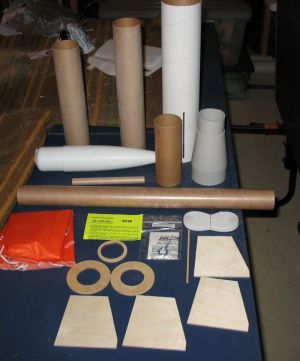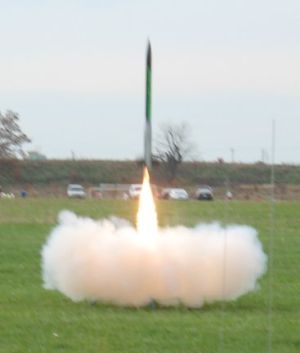| Construction Rating: | starstarstarstarstar_border |
| Flight Rating: | starstarstarstar_borderstar_border |
| Overall Rating: | starstarstarstarstar_border |
| Manufacturer: | LOC/Precision  |

Brief:
This is a single staged MPR/HPR rocket from LOC/Precision. This kit is a
stretched Norad with the motor mount upgraded to 38mm.
Construction:
The kit contains a 3" booster airframe, two 2.5" upper airframes, two
plywood centering rings, 4 plywood fins, plastic nose cone, parachute, elastic
shock cord, launch lug, shock cord mounting kit, and assorted hardware for
bulkhead assembly. All components were in great condition and typical
LOC/Precision high quality.
The build for this kit was fairly straightforward, however, there are a few steps to be mindful of. The kit starts with the building of the motor mount. You notice that the two centering rings contained in this kit are different sizes. This is because the motor tube extends through the plastic transition and ends in the smaller airframe tube above the transition. So to start the build, the upper (smaller) CR is attached to the motor tube. I deviated from the instructions a bit here, as I added a third centering ring so I could sandwich my fin tabs between two centering rings. After the upper CR was attached, the transition was slid onto the motor tube and held below the upper CR. I then attached my middle CR, trapping the transition between the two rings while the epoxy set up. The booster body tube was then slid over the lower CR and the lower shoulder of the transition and the assembly was epoxied into place.
 While
this was curing, I journeyed to the second deviation from the norm for this
kit. Instead of using the stock SC mount, I built a bulkhead from plywood and
drilled ejection vent holes around the perimeter of the bulkhead. I also
inserted a screw eye into the center of this bulkhead and secured it with a
washer, nut, and JB weld, and the shock cord was tied to this screw eye.
While
this was curing, I journeyed to the second deviation from the norm for this
kit. Instead of using the stock SC mount, I built a bulkhead from plywood and
drilled ejection vent holes around the perimeter of the bulkhead. I also
inserted a screw eye into the center of this bulkhead and secured it with a
washer, nut, and JB weld, and the shock cord was tied to this screw eye.
Once everything had cured, I fed the shock cord through the lower section of the upper body tube and epoxied it into place over the upper CR and upper shoulder of the plastic transition. While that was curing, the nose cone was attached to the payload tube with screws (I wanted to maintain access to the payload section for future payloads). I also attached the screw eye to the upper bulkhead and epoxied the bulkhead into the tube coupler that holds the two upper body sections together. Then, the upper end of the SC was attached to this screw eye (after a quick link was attached about two feet from the top end of the shock cord). Airframe complete!
The fins were attached and filleted using 15 minute epoxy. Three blind nuts were added to the lower CR for motor retention and the lower centering ring was then attached. Instead of using the enclosed launch lug, I installed two rail buttons--one in the lower shoulder of the transition, and one in the middle centering ring.
PROs: Great components, easy fit, fairly easy build for someone who's built a few MPR/HPR kits.
CONs: Somewhat sparse directions that were kind of confusing in spots but were still workable. Not really a great choice for someone's first larger kit.
Finishing:
I filled the spirals with some spackling, sanded the whole thing down, and hit
it with two coats of primer. I kind of liked the paint scheme on the card in
the kit but wanted a few changes. I painted the whole thing silver--the bottom
would remain silver, however, the top would be metallic black so I wanted a
shiny undercoat. Instead of masking directly at the top of the transition, I
masked just above the transition to add something different to the look of the
rocket. The rest of the transition/booster was masked off, then the fins and
airframe above the transition were painted metallic black. It still needed
something: lettering! I bought some self-stick Monokote trim in bright lime
green and cut out letters to spell the name of the rocket. The green looks
awesome against the metallic black airframe!
PROs: Kit looks great when finished!
CONs: There are fairly deep tube spirals to fill.
Construction Rating: 4 out of 5

Flight:
The first flight of this bird was to be on a very busy day for me. The weekend
before Memorial Day, I was going to get my L1 certification on a different
rocket at the same launch. I prepped a 38mm/120 G61W, my first ever 38mm
reload. I added an RMS+ kit to bring it to about a 7 second delay. The motor
was prepped and inserted into the Norad Pro Maxx, then secured with three brass
strips screwed into the aft CR. I loaded onto the rail and hooked up the clips.
The button was pushed, and it roared off the pad with a brilliant white flame
behind it. She flew arrow straight with no spin and ejected the parachute right
at apogee to recover about 200 feet from the pad. This rocket has since flown
on a G77 and most recently on an H180 for a fabulous flight to about 1800 feet
or so! Each time, it has recovered with no damage whatsoever.
Recovery:
The recovery system on this rocket is typical LOC: elastic shock cord and nylon
parachute. I don't like the standard shock cord mount for LOC (the nylon string
epoxied to the airframe), so I changed that during the build, and a lot of
people don't like the elastic shock cord. I don't mind it, but in the future I
might change it out to tubular nylon for added insurance.
While building the rocket, I looked at the seemingly huge orange nylon parachute and thought there was no way it was going to fit in the airframe and allow the coupler from the payload section to go all the way in, especially with enough dog barf in there to protect it. I was right--I couldn't pack it small enough for the payload section to properly mate up with the rest of the rocket. The kit says it comes with a 36 inch chute. That seemed rather big for a rocket that was about the same size and slightly lighter than my PML Small Endeavour, so I use the parachute from my Small Endeavour when flying this kit.
PROs: Easy to prep, no special steps.
CONs: Stock chute is way too big to fit and would drift forever if used. Some may also view the elastic shock cord as a con.
Flight Rating: 3 out of 5
Summary:
I'm very happy with this kit. It builds well and allows you to think about it
instead of mindlessly following instructions. It looks great, has a pretty
impressive profile on display, and also looks fabulous in the air on both G and
H loads. All in all, this kit would be an asset to anyone's collection.
Overall Rating: 4 out of 5
 |
 |
Flights
 |
 |